A big part of surviving disasters and trying times is simply being prepared. Yes, skills are critically important, but you’ll need plenty of supplies, tools, food, and more if you want to be ready to counter all the curveballs that life is going to throw at you…
Increasingly, lots of folks around the country are stepping up and getting ready for tough times by putting together a three-day survival kit, just like the authorities in the government and at the state level recommend.
That’s great news, and I’m glad to hear it, but if you have to deal with the aftermath of a major disaster or societal breakdown, you’re going to be completely on your own for a lot longer than a few days.
Going for weeks while completely on your own is tough and downright intimidating, but you can still prepare for that very occasion with the right approach. Below, I’m giving you a list of everything you need to include in a 14-day survival kit.
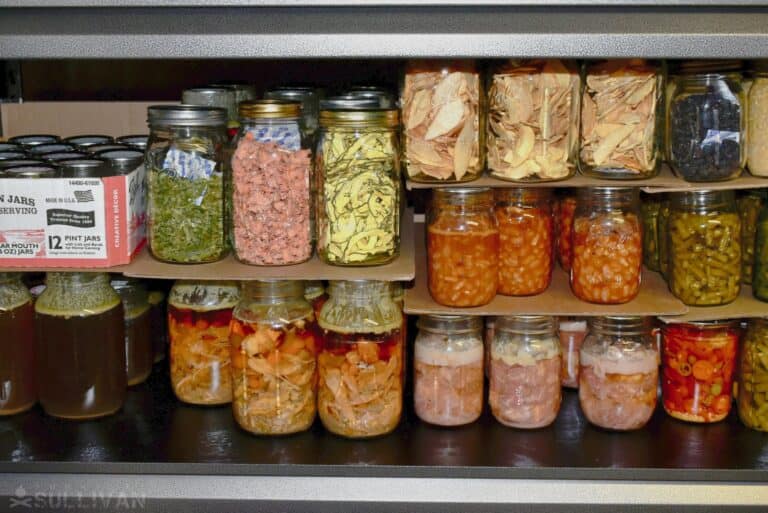
Home (pressure) canned and dehydrated long term pantry meals and sides.
Food Supply
Pretty much everyone by now knows that you need a supply of food on hand that is ready to eat or easy to prepare in a survival situation. Long shelf life, no refrigeration needed, and either ready to heat-and-eat or prepared with just a little bit of hot water is ideal.
For your 14-day survival kit, you just need a lot more of it.
A good benchmark in terms of calories is 2,000 per adult per day. That means an adult needs 28,000 calories for a 14-day duration. I remind you, that’s the baseline.
You can get by with less, but you’ll suffer reduced physical and mental performance, and if you have to work hard during this time, you’ll need more calories to keep your energy up.
If you don’t want the storage requirements to go totally out of control, consider space-efficient freeze-dried survival food, bulk pasta, rice, and things like that.
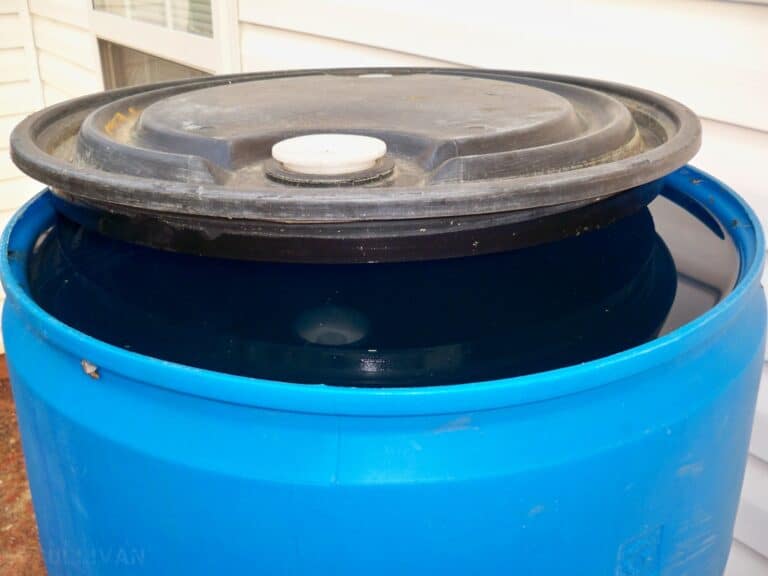
the top of a blue rain barrel filled with water
Water Supply
Just like with food, everyone knows that we need water to survive, and for the purposes of this kit, you just need more of it. The baseline is one gallon per person per day, as that will cover drinking needs and most situations and also leave some for hygiene, cleanup, and other utility tasks.
But this can be a ton of water if you’re going to store it in bottles or even large jugs. Setting up your 2-weeks stockpile is the perfect opportunity to look into bulk water storage solutions like cans or even barrels.
Just keep in mind that these containers are very, very heavy and hard to move once they are filled! Make sure your floor is up to the task.
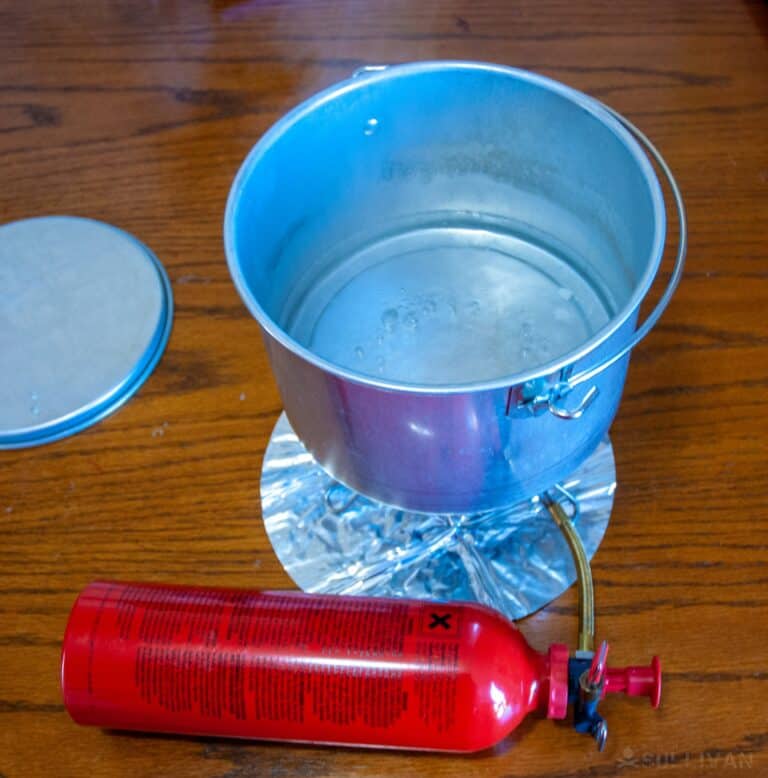
Whisperlite stove with pot of boiling water
Grill or Campstove
A major disaster or other crisis is highly likely to cut the supply of whatever you need to cook food in your home, be that gas or electricity.
If you want to continue cooking, or even just boil water, you’ll need a backup… A backyard grill or even something as simple as a camp stove with a sufficient supply of propane can definitely do the job.
In any case, depending on what you choose, you’ll need lots of fuel canisters or charcoal to help get you through, though judicious use of either solution and picking foods that don’t require cooking or boiling water to make them edible can cut down on your fuel requirement.
And as always, don’t use these things inside! Carbon monoxide gas can and will kill you.
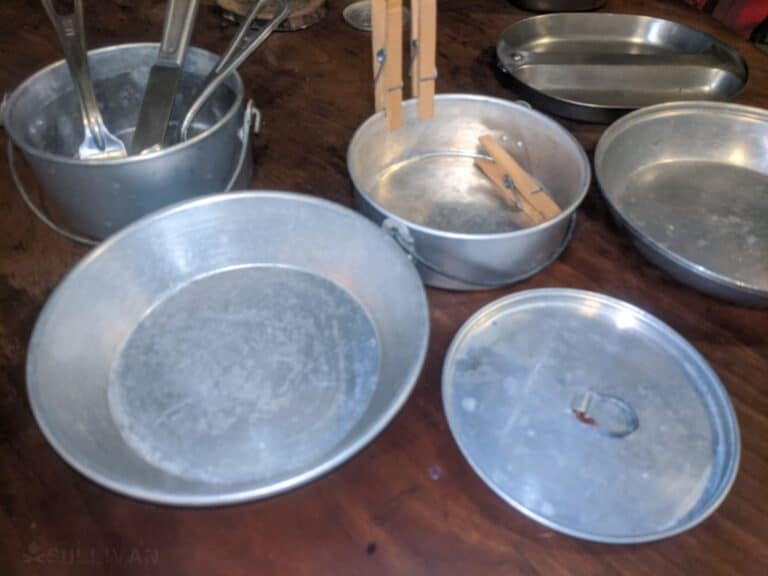
a mess kit
Mess Kit
When you’re roughing it, it’s fine to eat out of a can or pouch for a couple of nights before throwing away the trash. But surviving for two whole weeks, wherever you are, is made a whole lot nicer if you have an appropriate mess kit consisting of plates and utensils.
You’ve got two schools of thought here: You might choose metal, lightweight camping-style mess kits that can be washed and reused, though this will require water of course, or you can go with disposals that you can simply throw away when you’re done, saving time and labor.
Both are valid; just pick whichever is best for you based on your family and circumstances.
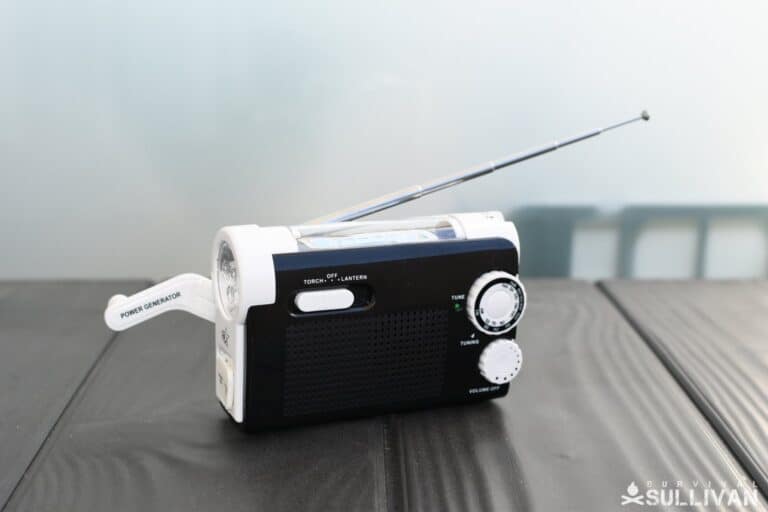
hand-crank AM/FM radio and lantern
Radio
Radio might seem antiquated in the era of the cell phone, but for survival, they are truly indispensable. That’s because radios are self-contained methods for receiving and, with the right one, transmitting signals with no other infrastructure needed.
At the least, you should have an emergency radio, one capable of receiving NOAA weather alerts and broadcasts. This can help you keep up to date on emerging threats and the situation overall, including evacuation points and routes and a whole lot more.
But my preference is to get a good handheld ham radio, even if it’s just a cheap Baofeng. This requires more investment in terms of money and also know-how, but it allows you to both send and receive even if cell phone networks are completely out of commission.
Plus, a ham radio can access dedicated emergency frequencies for the same purpose as a standalone emergency radio, giving you more capability in the same package.
Obviously, using a radio to transmit is a lot more effective if you know who you’re reaching out to, so if you have friends or family in the nearby area, this is a great way to ensure that you can all stay in touch.
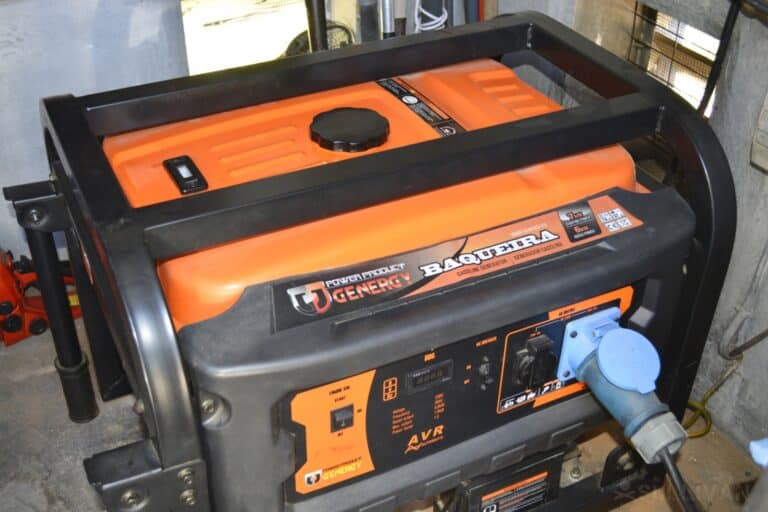
a gas generator
Generator or Solar Charger
Like I said above, count on the power grid going down during any sort of emergency situation that has this kind of duration. You can get by without electricity, sometimes, but not all the time.
If you or a family member require electrical infrastructure for life support, either in the form of ventilators or refrigerated medicine, you should definitely invest in a generator.
Even if that doesn’t describe your situation, it can make the long days a lot more comfortable, and that’s worth considering.
If you don’t think you need a generator, at least consider a solar charging system that can keep your phones, radios, and other electronics topped off, assuming, of course, that they use rechargeable batteries.
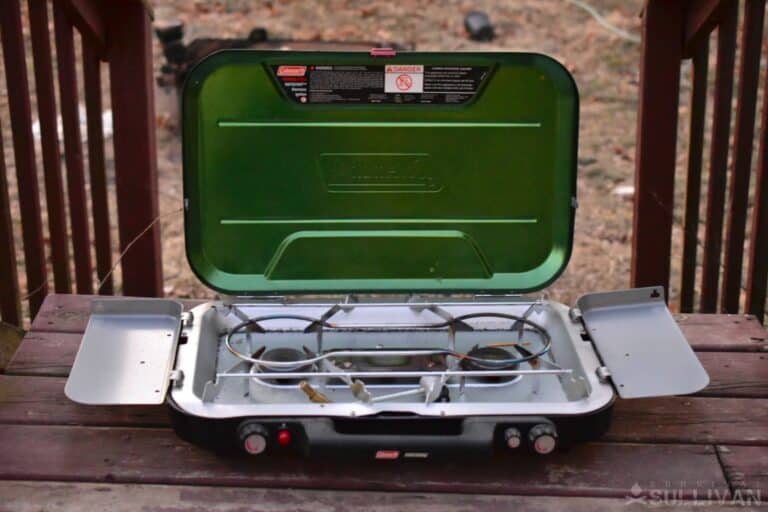
A 2-burner Coleman propane camping stove.
Propane Heater
If you live in a colder region or just have some pretty chilly nights, propane heaters are indispensable. Many of these efficient and easy-to-use devices are rated indoor safe with even the most rudimentary ventilation, and propane is both affordable and has a very long shelf life.
A couple of these along with some other preparations in the form of blankets and sleeping bags can keep you and your whole family toasty warm if you don’t have a fireplace.
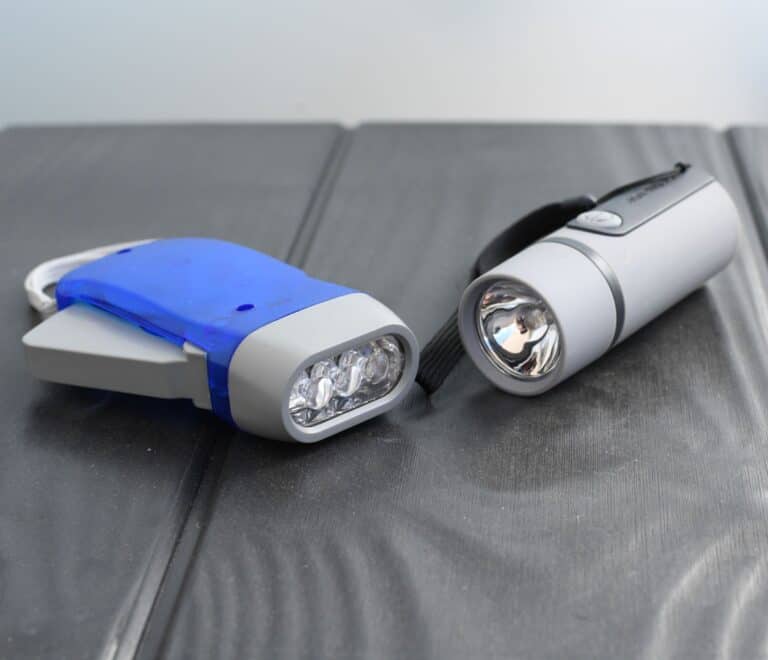
The flashlight on the left is hand-crank, the one on the right runs on an AA battery.
Flashlights and Headlamps
Bad things happen in the dark, and they are especially prone to happen in the middle of an already bad situation.
Keep the darkness at bay and increase safety, or keep working after sundown, by keeping a good supply of flashlights and headlamps on hand. Don’t neglect the headlamps especially: they are indispensable when you need to work hands-free or are traveling on foot in the dark.
Electric Lanterns
One of my favorite inclusions for a 14-day survival kit is a good electric lantern or two. Nothing beats them for providing comforting wide-area light using a minimum of power.
They’re also extremely portable, and modern LED versions with multiple modes can last for many days using just one set of C or D batteries.
The best thing about electric lanterns compared to the older liquid-fueled kind is that they really don’t present much of a fire hazard except in the case of rare and catastrophic malfunctions. Knock over a kerosene lantern, though, and it can burn your whole house down!
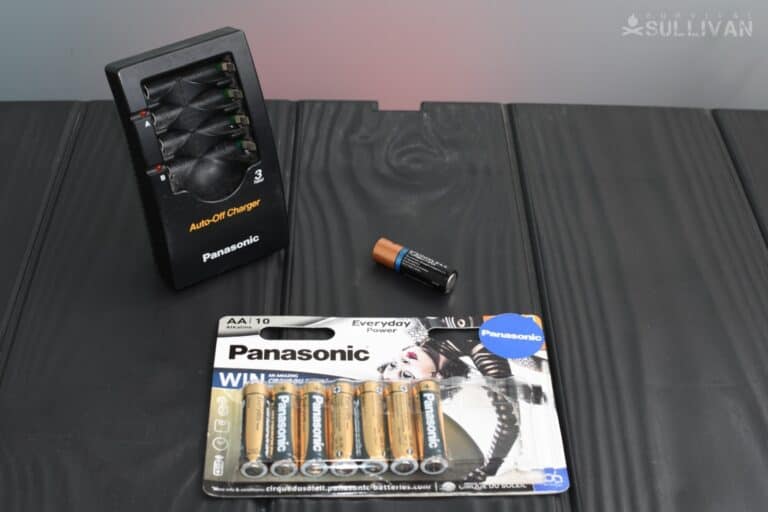
AA batteries and charger
Spare Batteries
I’ve mentioned several electronic devices already, from flashlights to electric lanterns just above but also radios. These devices need electricity, typically in the form of batteries.
Keep a large supply on hand to keep them fueled and use them sparingly and strategically so that your supply will last as long as you need them during the crisis.
Keep in mind, many of the high-performance lights, headlamps, and lanterns of our day use rechargeable cells that are built-in.
They typically need to be charged via a charging cable that plugs into a vehicle or wall adapter. If that’s the case for your models, you should definitely invest in that solar charger if you don’t have a generator so you can plug them in.
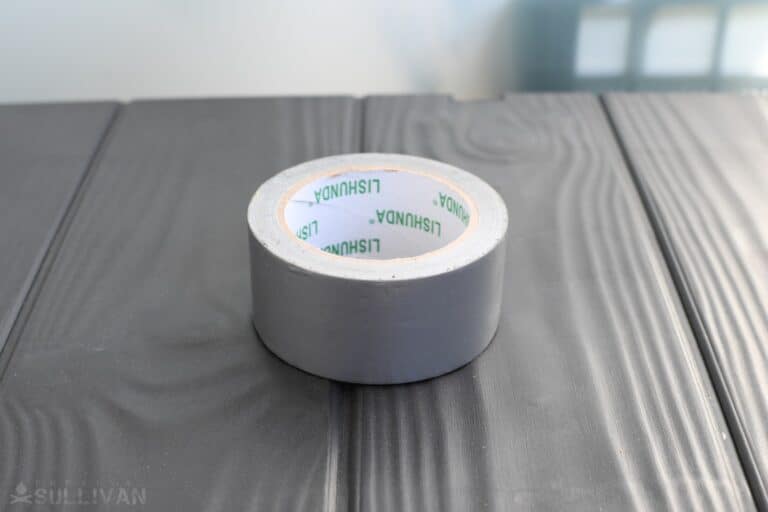
a roll of duct tape
Duct Tape
Duct tape is either a meme or a long-running joke depending on who you talk to in survival circles, but it’s all good-natured because this stuff is actually indispensable. For hasty repairs, improvising solutions, and even quick waterproofing, duct tape gets it done.
It can be used for countless tasks, and we’ve talked about it here on Survival Sullivan several times, so make sure you check out those articles. What’s important, though, is that you have a few rolls on hand.
Heavy Rolled Plastic Sheeting
This might seem like a strange inclusion to some folks, but seasoned preppers know what this stuff can do for you.
You can use thick plastic sheeting for all kinds of tasks, including catching rainwater, waterproofing surfaces, or repairing damage to windows, roofs, and more, and even sanitation concerns to include the disposal of waste, more on that later, or wrapping up a dead body if worse comes to worse.
A big roll or two won’t take up much room in your closet or storeroom, and believe me, you’ll be glad you’ve got it the longer the situation drags on. Also, just a reminder, don’t get the paper-thin stuff because it tears too easily; 4 to 6 mil is my preference.
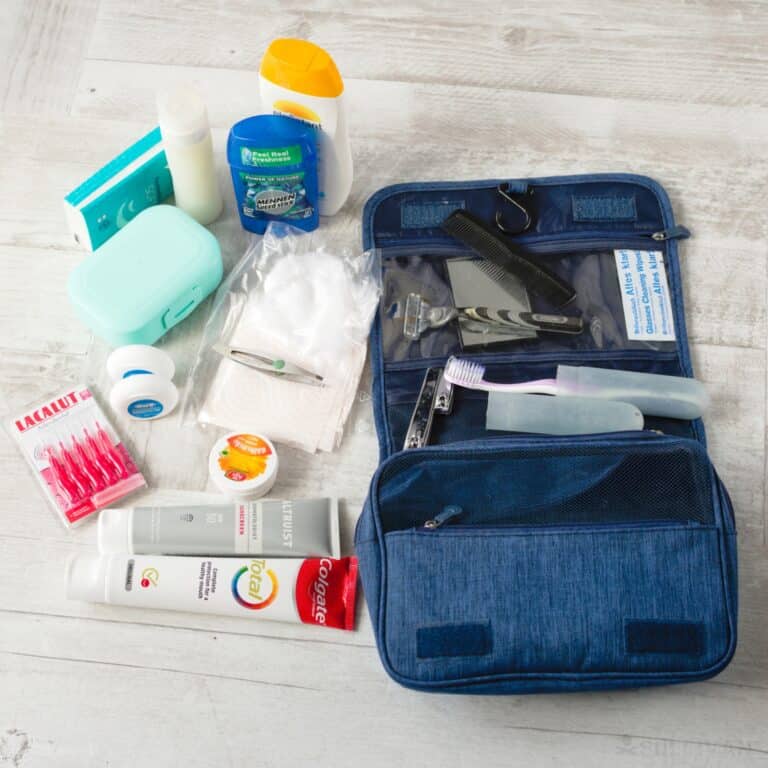
hygiene kit next to pouch
Sanitation Kit
Tragically, one of the most commonly overlooked factors of living in a post-SHTF long-term scenario is getting rid of bodily waste. Yep, you’ll have to go on answering Nature’s call as normal, of course!
The problem is that sewer systems, and water, will very likely be offline or intermittent. If you’ve got a septic tank, you might be lucky, but that too could be damaged, or your toilet could be destroyed by a natural disaster.
In this case, a composting or camping toilet, or even a couple of large buckets with gasketed lids along with some sawdust, kitty litter, contractor-grade trash bags, and a bottle of bleach or heavy-duty disinfectant can help you do your business and, if needed, store the waste without making a hideous mess until it can be dealt with properly.
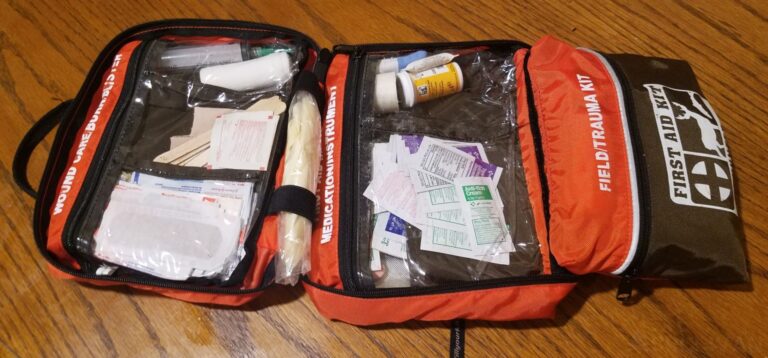
a compact first-aid kit
First-Aid Kit
Injury and disasters go hand in hand, unfortunately. Chances are you or someone in your family or group will be injured at some point, even if it’s just taking care of things that need dealing with so you can keep on living.
A good first-aid kit will include things like gauze, antiseptic, burn cream, various adhesive bandages, wound closures, and things like that.
If you’ve got the skills, either as a nurse, EMT, paramedic, surgeon, and so forth, or if you’ve taken a first-responder class, you’ll definitely want to toss in some trauma supplies like tourniquets, hemostatic gauze, splints, and braces, and so on.
Medicines
Complementing your first-aid supplies, include a big stash of over-the-counter and, if you need them, prescription medications.
This means stuff for common illnesses and conditions like cold and flu, indigestion, nausea, pain, and so forth.
A great thing to get, if your doctor will go along with it, are wide-spectrum antibiotics that can be a great insurance policy against more substantial wounds. Also be sure to include those prescription meds that any of your family members need for conditions like heart trouble, blood pressure, mental illness, and so forth.
Fire Extinguisher
The utility of a fire extinguisher should be obvious, and you should really have one of these in your home no matter what! If you don’t, now is the perfect time to get one, and better yet, get two.
An ABC-rated extinguisher might be the only thing between you and your house burning down, and under the circumstances, the risk of a house fire is greatly increased.
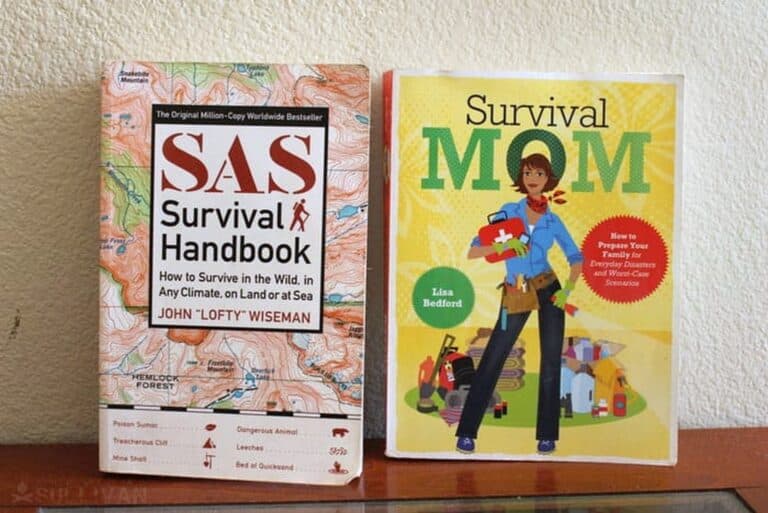
two survival staples: The SAS Survival Handbook, and The Survival Mom
Books, Games, Comfort Items
Sometimes, the biggest part of surviving is just waiting around for the cavalry to show up, assuming you have all of your basic needs met.
But boredom, anxiety, and too much sitting around thinking what if can lead to frayed nerves, flaring tempers, and a death spiral of accusations, attacks, and arguing that can tear your group or your family apart.
Help keep this at bay by including things like books, various games, puzzles, crosswords, and other comfort and recreational items that can bring folks a moment of respite from a bad and potentially very scary situation.
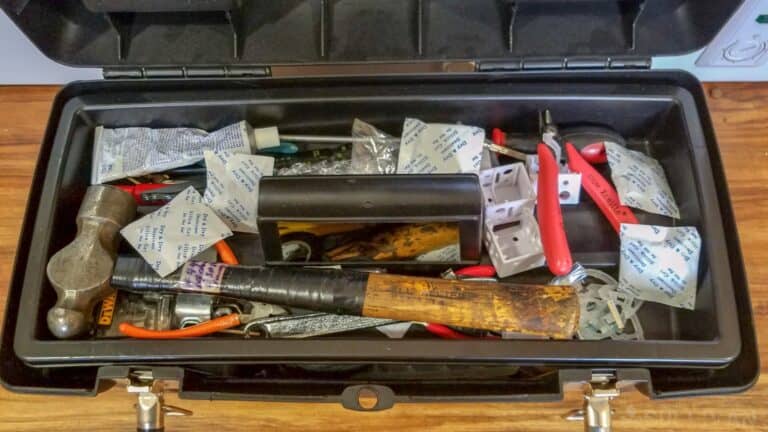
tools and silica gel packets inside toolbox
Sockets, Wrenches, Pliers, and Other Tools
A very likely occurrence in the case of a destructive natural disaster is that utilities like water, sewage, and gas lines will start leaking or break entirely.
Obviously, this needs to be dealt with at once. A toolkit consisting of various appropriately sized sockets, wrenches, and stout pliers will allow you to shut off the appropriate valves where you can reach them.
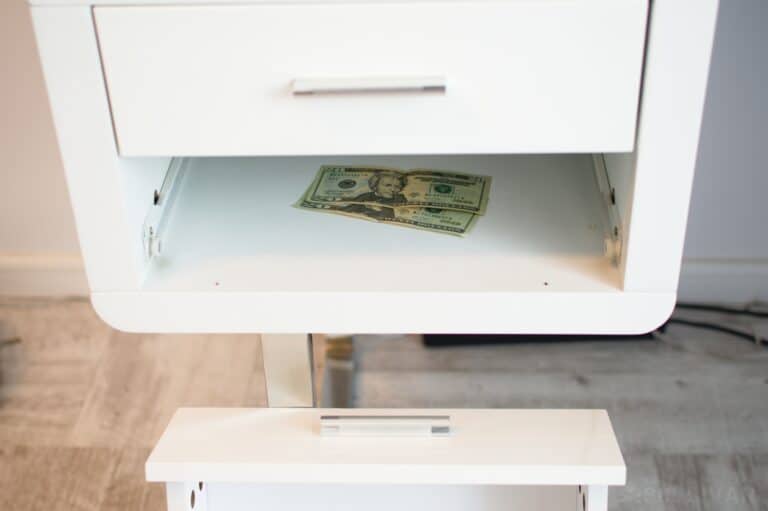
cash hidden under desk drawer
Cash
Don’t overlook the value of having a stash of cold, hard cash on hand in times of trouble. Whether you need to get desperately needed supplies or gear, buy a lift out of a devastated area, or get a favor from someone, cash will do it.
I recommend you have about $2,000 on hand in smaller bills since there’s no guarantee you’ll be able to get change.
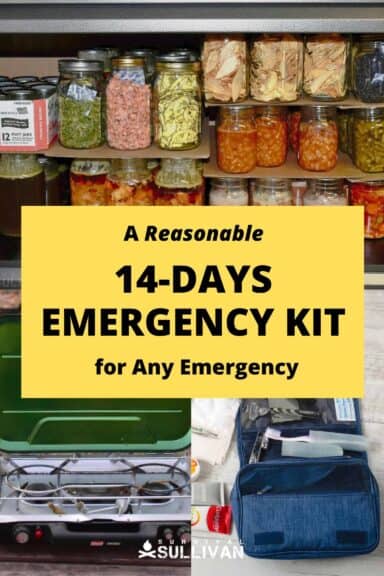
The post A Reasonable 14-Days Emergency Kit for Any Emergency appeared first on Survival Sullivan.
By: Tom Marlowe
Title: A Reasonable 14-Days Emergency Kit for Any Emergency
Sourced From: www.survivalsullivan.com/two-weeks-survival-kit/
Published Date: Thu, 04 Apr 2024 10:09:22 +0000
------------------------
 What is BushcraftSurvival SkillsToolsVideosBushcraft CampsBushcraft KitsBushcraft ProjectsPrivacy PolicyTerms And Conditions
What is BushcraftSurvival SkillsToolsVideosBushcraft CampsBushcraft KitsBushcraft ProjectsPrivacy PolicyTerms And Conditions
